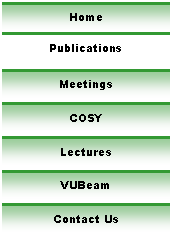
|
Reprint Server |



Rigorous Numerical Analysis with High-Order Taylor Models
A Dissertation
In partial fulfillment of the requirements for the degree of Doctor of Philosophy from Michigan State University.
Abstract
Interval techniques have been utilized for rigorous numerical analysis since the 1960s. However, their use has been limited by the dimensionality curse and the dependency problem. The recently developed Taylor model approach alleviates these problems and allows the use of validated numerics in a wide range of applications. To broaden the applicability of the Taylor model method, we introduce new algorithms for the inversion of functional relations and the integration of differential algebraic equations.First we present a new method for computing verified enclosures of the inverses of given functions over large domains. The approach utilizes Taylor models and the sharpness of the enclosures scales with a high order of the domain. An integral part of the new method is the rigorous determination of invertibility of high dimensional functions over large domains, which is reduced to a verified linear algebra problem involving only first derivatives of the function of interest. Several examples highlighting various aspects of the methods are discussed.
Differential algebraic equations (DAEs) describe important problems in mechanical and chemical engineering. Existing algorithms for the integration of DAE initial value problems have traditionally been restricted to low-index systems and until recently, no practical scheme for the verified integration of DAEs existed. Recognizing the antiderivation as a natural operation on Taylor models yields a method that treats DAEs within a fully differential algebraic context as implicit equations made of conventional functions and the antiderivation. The resulting integration scheme can be applied to high-index problems and allows the computation of guaranteed enclosures of final coordinates from large initial regions.
To demonstrate the general applicability of the Taylor model approach, we present results from verified asteroid orbit integrations and the theory of Hamiltonian systems. We show that the newly developed methods are practical and can indeed outperform conventional interval methods in a wide class of problems. Finally, we discuss some details of implementing interval libraries on general purpose computers and present the concept of language independent software development, which has been used for the design and implementation of the C++ and Fortran 90 interfaces to COSY Infinity.
J. Hoefkens (2001)
Download
Click on the icon to download the corresponding file.
![]() Download Adobe PDF version (3970105 Bytes).
Download Adobe PDF version (3970105 Bytes).
![]() Download Postscript version (8709950 Bytes).
Download Postscript version (8709950 Bytes).
Go Back to the reprint server.
Go Back to the home page.
This page is maintained by Kyoko Makino. Please contact her if there are any problems with it.